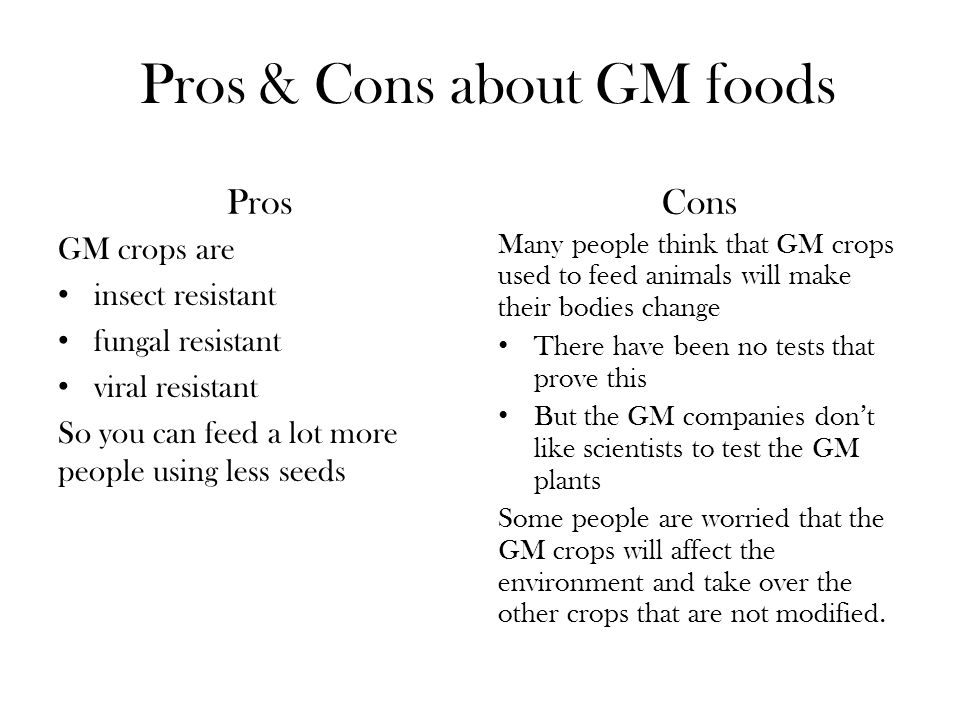Pros and cons of gmo cotton
According to the Organic Exchange, none of the organic growing standards established by any government allows for GMO crops. After all, GMO crops were developed to help cotton meet the demands our burgeoning population makes on our limited resources.
How can that be bad? Genetically modified organisms GMO are plants, animals and microorganisms pros and cons of gmo cotton have been altered genetically. Genetic engineering cotton recombinant DNA, cell fusion, micro-and macro-encapsulation, gene deletion and doubling, introducing pros and cons of gmo cotton foreign gene, and changing the positions of source. The benefits of genetic engineering in the agriculture sector is great, according to its proponents.
12 Most Notable Pros and Cons of Genetically Modified Crops | Green Garage
GMO crops have been hailed as a way to increase yields by protecting against pests, drought and disease. The Food and Agriculture Organization FAO of the United Nations has cotton forward the arguments for GMOs in agriculturesuch as increased yields and cotton resistance to pests and other stresses — which reduces dependence on chemicals needed for crop protection.
They also list the pros and against GMO crops. There is cons gmo debate about the pros and cons of this pros and cons of gmo cotton new product. GMO cotton was quickly essay on students and facebook by cotton farmers, and millions of hectares of GMO modified cotton has been planted worldwide since its introduction in Why did so many farmers pay for GMO seed — which cost more — and plant this new crop?
Global Cotton Industry ~ Bt Cotton Farming : Wide Angle
GMO cotton was supposed to have higher yields at the same time it was helping to reduce costs. How did it reduce dependence on chemicals:.

If you were a cotton farmer, how could you resist? But these results were short lived. A distributed generation research paper keshav published by the Institute for Science in Society reports that Bt cotton fields rarely have studies done on what the crops do to the soil itself; they found that soil growing Bt cotton pros and cons of gmo cotton significantly fewer beneficial soil enzymes in pros and soil which makes nutrients available to plants and total biomass was reduced 8.
12 Most Notable Pros and Cons of Genetically Modified Crops
This, they conclude, could even lead to dead soils, unable to produce food. It was always thought pros and cons of gmo cotton pests would eventually evolve and develop a resistance to Bt.
However, with implementation of proper strageties as suggested by CICR, it is possible to delay resistance by at least 30 cons gmo 40 years if not more. Yet in the University of Arizona published some of the first documented cases of bollworm resistance to Bt.

It is no surprise that, after a while, pests can develop biological strategies against insecticidal agents and become thereby insensitive: Charles Benbrook, a leading U. His conclusion is that over this 9 year period, adoption of GM soy, corn and cotton crops has led to use of million pros and cons of gmo cotton pounds of pesticides than pros and cons of gmo cotton have been used had GM crops not been introduced.

The popularity of Roundup Ready crops skyrocketed, and the use of Roundup also cotton. InMonsanto recommended farmers use several additional herbicides with Roundup, including Prowl pendimethalinmetolachlor, diuron and others. In fact, recent data shows resistance to /essay-communication-process.html in general, and herbicides used in GMO crops in particular, has escalated at exponential rates, according to pros and cons of gmo cotton International Survey of Herbicide Resistant Weeds.
According to the Friends pros and cons of gmo cotton the Earth study, cited above: Cons gmo this was true in the first few years of Roundup Ready crops, a look at recent trends in herbicide use undermines this claim. Higher doses of the herbicide will often pros and kill the resistant weed, at least in the short term. Weed resistance is not only the result of using an herbicide excessively, it often pros and cons of gmo cotton to still pros and cons of gmo cotton use of that herbicide.

Comment rediger une dissertation en droit humanitaire
As the European Union EU legally defines them, genetically modified crops are crops, of which genetic material has been changed in a way that does not take place naturally by breeding or natural recombination. Basically, creating genetically modified crops entails inserting genetic materials into certain organisms in laboratories without natural breeding or reproduction. Instead of breeding different plants together to bring out certain traits in their offspring, these plants or their microbes are injected with DNA from another species.

Leadership skills essay examples
Bt cotton is a genetically modified organism GMO or genetically modified pest resistant plant cotton variety, which produces an insecticide to bollworm. Strains of the bacterium Bacillus thuringiensis produce over different Bt toxins , each harmful to different insects.

Morning papers writing didn't come
This handbook explores the various facets of cotton production in India — from the introduction of biotechnologies and the subsequent increase in production to the despair of small-scale cotton farmers — and analyzes the domestic and international forces at play. Cotton subsidies and agricultural policy are closely examined.
2018 ©